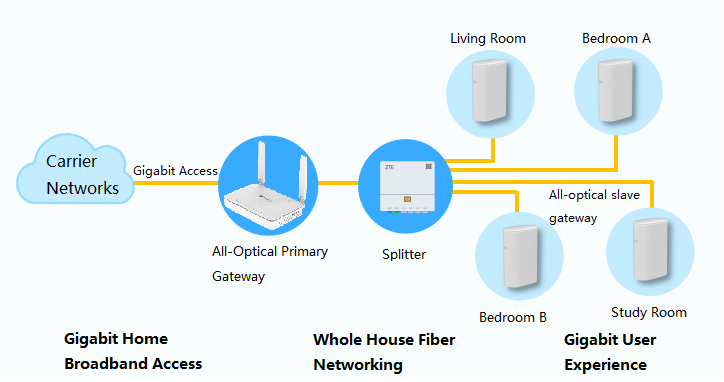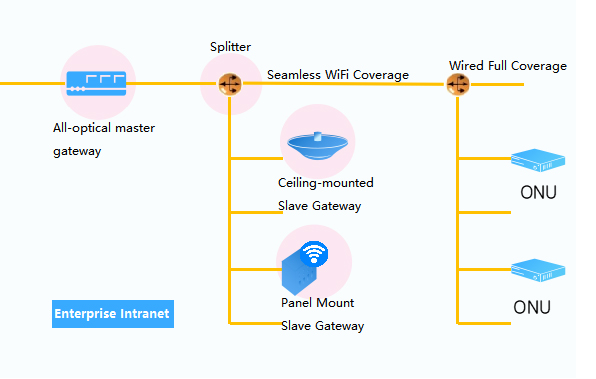FTTR (Fiber to the Room) refers to replacing network cables with optical fibers and deploying all-optical devices to achieve gigabit network coverage in every room of the house.
So, what are FTTR-H and FTTR-B? What is the difference between them?
FTTR-H
FTTR-H:Home FTTR, the home all-optical networking solution. By upgrading the transmission medium, upgrading the equipment, and simplifying the network, it is a one-step solution to the high-frequency home networking problems such as old terminals, substandard transmission medium, and mismatched packages.
ZTE Room PON 3.0 all-optical solution solves the bottleneck of home speed up in one step and realizes whole-house ultra-gigabit coverage.

FTTR-B
FTTR-B:Business FTTR, which stands for Fiber-To-The-Room for business, is a Wi-Fi solution designed for enterprise scenarios. It uses a full-fiber network solution that combines fiber access, optical-electrical hybrid cable, and Wi-Fi6 to extend Wi-Fi coverage to every corner of the enterprise.
ZTE OfficePON 3.0 full-fiber solution provides an ultra-gigabit experience for enterprises and solves the internal network bottleneck of enterprises in one step.

Different Daily Business
FTTR-H: It is aimed at home internet access, and provides network services for social, shopping, online classes, video, games, and other learning, entertainment, and leisure activities for family members. Most of the customers of FTTR-H are scenarios with small network coverage areas, with fewer gateways and fewer users.
FTTR-B: It is aimed at enterprise production and operation, and provides network services for online work activities of enterprise employees, such as live streaming, online meetings, cloud office, etc. Most of the customers of FTTR-B are scenarios with large network coverage areas, with more gateways and more users, and some value-added service needs for enterprises.
Different Device Forms
FTTR-H: The master and slave gateways use plastic shells, which have the characteristics of lightweight, easy molding, etc., which can reduce the overall weight of the device and make it easier to install.
FTTR-B: The master gateway uses a metal body, and the slave gateway uses a plastic shell. According to the specification requirements of enterprise gateway products, they have better heat dissipation performance, higher environmental adaptability, and more stable MTBF performance.
Different Concurrency Value
FTTR-H: The home application scenario mainly involves social, shopping, online classes, video, games, and other learning, entertainment, and leisure activities, which do not have high concurrency scenarios.
FTTR-B: The enterprise focuses on production and operation, and needs multiple people to access the internet smoothly simultaneously, ensuring that the enterprise production and operation network is not interrupted. The concurrency needs to withstand the test, and the stability requirements are high. It can support up to 300 users online at the same time.
Different Anti-Interference Ability
FTTR-H: In the home scenario, if multiple Wi-Fi are in the same space, the interference of the same frequency or adjacent frequency band is more serious.
FTTR-B: In the enterprise network environment, the interference between the wireless frequency bands of multiple network devices can be greatly reduced by effective network optimization configuration.
Different Internet Behavior Management
FTTR-H: For families with teenagers and children, parents can limit the use of applications such as games, videos, shopping, etc.
FTTR-B: For enterprises with special requirements, not only can they limit the speed of specific applications, but they can also achieve multi-dimensional speed limit based on port, SSID, and STA, and ensure the priority control of the enterprise intranet according to the internet demand, ensuring the priority of the enterprise office applications.
Different Acceleration
FTTR-H: For home users, games and overseas education websites can be accelerated.
FTTR-B: Enterprises can accelerate office applications and live streaming services, and also have faster uplink transmission speed.
Different Security
FTTR-H: Home users have weaker requirements for internet security protection capabilities compared to enterprises.
FTTR-B: Enterprises involve business secrets and important documents. In terms of ensuring intranet security, FTTR-B has more technical methods. For example, FTTR-B can control access devices through multiple authentication methods such as password authentication, MAC authentication, local Portal authentication, etc., provide security protection capabilities such as anti-phishing, anti-flooding attack, anti-deception attack, etc., and can also hang a firewall to enhance the enterprise intranet security protection level.


























